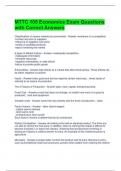Exam (elaborations)
MTTC 105 Economics Exam Questions with Correct Answers
- Course
- Institution
MTTC 105 Economics Exam Questions with Correct Answers Classification of various markets by economists - Answer--existence of a competition -number and size of suppliers -influence of suppliers over price -variety of available products -ease of entering the market 5 types of Market Failure ...
[Show more]



